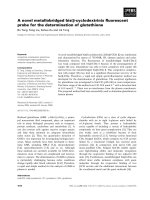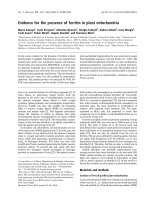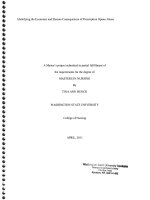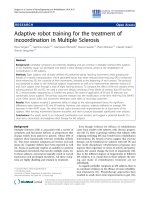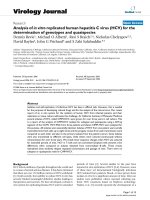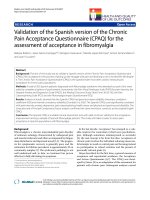Hollow fiber protected microextraction for the determination of pollutants in complex matrices
Bạn đang xem bản rút gọn của tài liệu. Xem và tải ngay bản đầy đủ của tài liệu tại đây (916.59 KB, 79 trang )
HOLLOW FIBER-PROTECTED MICROEXTRACTION
FOR THE DETERMINATION OF POLLUTANTS IN
COMPLEX MATRICES
SHU YAN
(B. Sc.)
A THESIS SUBMITTED
FOR THE DEGREE OF MASTER OF SCIENCE
DEPARTMENT OF CHEMISTRY
NATIONAL UNIVERSITY OF SINGAPORE
2003
ACKNOWLEDGMENTS
I would like to extend my most sincere gratitude and appreciation to my supervisor,
Professor Lee Hian Kee, for his guidance and encouragement since I came to study at
National University of Singapore in July 2001. He gave me much instruction on the
research topics and many things in life. His expertise, dedication and interests in
science have inspired me a lot. He gave me much freedom to do my research from the
choice of research project to the implementation process. Undoubtedly, I will
remember the wonderful experience of working with him.
I’m also very grateful to Madam Francis Lim, Mr Shen Gang, Mr Tu Chuanhong, Mr
Zhu Liang, Ms Zhu Lingyan and Miss Sharon Tan for their constant help in my
research work. At the same time, other friends in the laboratory also helped me in
different ways.
I am grateful to the National University of Singapore, Faculty of Science for the award
of a research scholarship. Many staff member of the Department’s General Office, the
Analytical Laboratory, NUS’ Science Library and the Central Library have been so
kind to me.
Last but not the least; I am grateful to my parents, my boyfriend and all my friends in
Singapore and in China for their warm support.
i
TABLE OF CONTENTS
ACKNOWLEDGMENTS
i
TABLE OF CONTENTS
ii
SUMMARY
vi
LIST OF TABLES
ix
LIST OF FIGURES
x
LIST OF ABBREVIATION
xii
CHAPTER 1 INTRODUCTION
1
1.1 Extraction methods for environmental analysis
1
1.1.1 Liquid-liquid extraction (LLE)
2
1.1.2 Solid-phase extraction (SPE)
3
1.1.3 Solid-phase microextraction (SPME)
4
1.1.4 Liquid-phase microextraction (LPME)
5
1.1.5 Other extraction methods
8
1.2 Scope of our project
9
CHAPTER 2 PRINCIPLES OF LPME
11
CHAPTER 3
13
DETERMINATION OF ORGANOCHLORINE PESTICIDES IN MILK BY
LIQUID-PHASE MICROEXTRACTION COUPLED WITH GC-MS
3.1 Introduction
13
3.2 Experimental
15
3.2.1 Materials and Chemicals
15
ii
3.2.2 Instrument
15
3.2.3 Milk sample preparation
16
3.2.4 Hollow fiber-protected microextraction (LPME)
18
3.3 Results and discussion
3.3.1 Optimization of liquid-phase microextraction
18
18
3.3.1.1 Organic solvent selection
19
3.3.1.2 Effect of extraction time
20
3.3.1.3 Effect of rotation rate
21
3.3.1.4 Effect of pH
23
3.3.1.5 Effect of types and concentration of solvent added into the
23
sample
3.3.1.6 Effect of temperature
25
3.3.2 Quantitative analysis
25
3.3.3 Real milk sample analysis
26
3.4 Conclusions
CHAPTER 4 DETERMINATION OF POLLUTANTS IN SOIL
27
29
4.1 DETERMINATION OF POLYCYCLIC AROMATIC HYDROCARBONS
IN SOIL BY HOLLOW FIBER-PROTECTED LIQUID-PHASE
MICROEXTRACTION
4.1.1 Introduction
29
29
iii
4.1.2 Experimental
31
4.1.2.1 Chemicals
31
4.1.2.2 Instrumentation
31
4.1.2.3 Preparation of standards and spiked sample
32
4.1.2.4 Liquid-phase microextraction procedures
32
4.1.3 Results and discussion
4.1.3.1 Optimization of hollow fiber-protected LPME
4.1.3.1.1 Organic solvent selection
33
33
35
4.1.3.1.2 Effect of added solvent and its proportion in sample
solution
35
4.1.3.1.3 Salt concentration
36
4.1.3.1.4 Agitation
37
4.1.3.1.5 Extraction time
39
4.1.3.2 Evaluation of method performance
39
4.1.3.3 Real soil samples
41
4.1.4 Conclusions
42
4.2 TRACE DETERMINATION OF CHLOROBENZENES IN SOIL BY
HOLLOW FIBER-PROTECTED LIQUID-PHASE MICROEXTRACTION
COUPLED WITH GC-MS
44
4.2.1 Introduction
44
iv
4.2.2 Experimental
46
4.2.2.1 Material and chemicals
46
4.2.2.2 Sample preparation
46
4.2.2.3 Hollow fiber-protected liquid-phase microextraction
47
4.2.2.4 GC-MS analysis
47
4.2.3 Results and discussion
48
4.2.3.1 Optimization of extraction
48
4.2.3.1.1 Organic solvent
48
4.2.3.1.2 Salt
49
4.2.3.1.3 Acetone
50
4.2.3.1.4 Extraction time
50
4.2.3.1.5 Stirring speed
51
4.2.3.2 Quantitative analysis
52
4.2.3.3 Real sample analysis
53
4.2.4 Conclusions
54
CHAPTER 5 CONCLUSION AND FURTHER WORK
56
REFERENCES
58
v
SUMMARY
Hollow-fiber combined with liquid-phase microextraction (LPME) is a kind of solvent
microextraction. It includes two-phase liquid-liquid microextraction (LLME) and
three-phase liquid-liquid-liquid microextraction (LLLME). Due to the protection of the
hollow fiber, the precision and stability of this method is increased significantly. Also,
the method can be applied to “dirty” samples such as soil, milk, etc.
This research focuses on the development and application of hollow fiber-protected
LPME to the determination of environmental pollutants in complex matrices, such as
milk and soil. LPME has been accomplished by extracting target compounds into a
small volume of acceptor solution present within the channel of a porous hollow fiber.
The method of combing hollow fiber-protected LPME with gas chromatography-mass
spectrograph (GC-MS) to determine organochlorine pesticides (OCPs) in milk and
chlorobenzenes in soil was developed in our study. Also, hollow fiber-protected LPME
coupled with gas chromatography (GC) was investigated to determine polycyclic
aromatic hydrocarbons (PAHs) in soil.
The procedure to determine OCPs in milk by hollow fiber-protected LPME coupled
with GC-MS was developed. OCPs were extracted from 5 ml milk samples into the
acceptor phase present within the channel of a porous hollow fiber. N-nonane chosen
as the acceptor solvent gave the most efficient extraction. Prior to the extraction, the
pH was adjusted to 2 in order to facilitate the extraction of OCPs from milk. During
the extraction, high partition coefficients were obtained by optimizing several
vi
experimental factors. These include extraction time, agitation speed, types of acceptor
phase, types of organic solvent added into the sample and temperature. Due to the large
sample volume to acceptor phase volume ratio (1250) and high partition coefficients,
the enrichment factors for all analytes were from 18 to as high as 203. The limits of
quantification at S/N=10 were between 0.5µg/l to 20µg/l and the limits of detection
(LODs) (S/N=3) were from 0.10µg/l to 10µg/l for all analytes in milk. Linearities were
between 0.5µg/l to 100µg/l in which r2 was higher than 0.9699 for all analytes.
PAHs in the soil were determined by hollow fiber-protected LPME coupled with
chromatography-flame ionization detector (GC/FID). Hollow fiber-protected LPME
optimized conditions were as follows: the extraction time was 15 minutes; 1250rpm
was adopted as the agitation speed and the concentration of acetone and salt in the
sample solution was 33% and 10% respectively. The LODs determined (S/N=3) were
from 0.037µg/g to 0.744µg/g for all tested PAHs in soil.
The hollow fiber-protected LPME coupled with GC-MS was developed for the
determination of chlorobenzenes in soil. The linear calibration curves were obtained in
the range of 10µg/kg to 50µg/kg. Coefficients of correlation (r2) were from 0.9740 to
0.9998. The LODs (S/N=3) were from 0.01µg/kg to 0.05µg/kg. The results showed
hollow fiber-protected LPME had good sensitivity and selectivity for determination of
chlorobenzenes.
Coupled with GC or GC-MS, hollow fiber-protected LPME proved to be simple, fast
and effective for milk and soil analysis. The affordable hollow fiber extraction devices
vii
were disposed after each extraction. This eliminated the possibility of carry over
effects. The results showed that LPME applied to the determination of pollutants in
soil and milk has low LODs and high selectivity compared with many conventional
solvent-based method, e.g liquid-liquid extraction, solid-phase extraction, etc.. It can
serve as an alternative method to conventional sample preparation techniques for the
determination of organic pollutants in complex matrices, such as soil and milk.
viii
LIST OF TABLES
Table 3.1
Retention time of OCPs analysed
Table 3.2
Performance of LPME: Limits of Detection (LODs), Linearity 26
of chart-plot, Correlation Coefficient, Enrichment Factor and
Relative Standard Detection (RSD)
Table 3.3
Hollow fiber-protected LPME Relative Recovery for spiked 27
milk samples (70µg/l and 10 µg/l spiked levels)
Table 4.1.1 Efficiencies of Various Organic Solvent (soil sample at a 34
concentration of 3µg/g)
Table 4.1.2 Main method parameters for LPME of 1g soil sample spiked 40
with PAHs at the concentration between 0.186 µg/g to 3.72 µg/g
Table 4.1.3 Determination of PAHs in real soil sample by standard addition
43
Table 4.2.1 Quantitative determination of chlorobenzenes in spiked soil 53
sample using hollow fiber-protected LPME
Table 4.2.2 Summary of results from determination of chlorobenzenes in 54
spiked soil sample after extraction by hollow fiber-protected
LPME
Table 4.2.3 Comparison of LODs
54
ix
LIST OF FIGURES
Figure 1.1
Schematic diagram of headspace SPME setup
5
Figure 1.2
Design of hollow fiber-protected LPME system
7
Figure 1.3
Diagram of the LLLME extraction unit
8
Figure 3.1
Chromatogram of OCPs extracted from spiked milk sample
17
Figure 3.2
Effect of different acceptor phase on hollow fiber-protected 20
LPME
Figure 3.3
Effect of extraction time on extraction efficiency of hollow 21
fiber-protected LPME
Figure 3.4
Effect of agitation on extraction efficiency of hollow 22
fiber-protected LPME
Figure 3.5
Effect of different solvents added to milk sample on 24
extraction efficiency of hollow fiber-protected LPME
Figure 3.6
Effect of percentage of acetonitrile in milk sample on hollow 24
fiber-protected LPME
Figure 4.1.1
Chromatogram of extract after hollow fiber-protected LPME 34
of spiked soil sample
Figure 4.1.2
Effect of acetone concentration on extraction efficiency of 37
hollow fiber-protected LPME
Figure 4.1.3
Effect of salt concentration on extraction efficiency of 37
hollow fiber-protected LPME
Figure 4.1.4
Effect of stirring rate on extraction efficiency of hollow 38
fiber-protected LPME
Figure 4.1.5
Effect of extraction time on extraction efficiency of hollow 39
fiber-protected LPME
Figure 4.2.1
Total ion chromatogram of chlorobenzenes from a spiked soil 48
sample
x
Figure 4.2.2
Effect of salt concentration on extraction efficiency of 49
hollow fiber-protected LPME
Figure 4.2.3
Effect of acetone concentration on extraction efficiency of 50
hollow fiber-protected LPME
Figure 4.2.4
Effect of extraction time on extraction efficiency of hollow 51
fiber-protected LPME
Figure 4.2.5
Effect of agitation on extraction efficiency of hollow 52
fiber-protected LPME
xi
LIST OF ABBREVIATION
Ac
Acenaphthylene
Ace
Acenaphthene
Anth
Anthracene
ASE
Accelerated solvent extraction
BaAn
Benzo[a]anthracene
BaPy
Benzo[a]pyrene
BbFl
Benzo[b]fluoranthene
BePe
Benzo[g,h,I]perylene
γ-BHC
Hexachlorocyclohexane
BkFl
Benzo[k]fluoranthene
Chr
Chrysene
DiAn
Dibenz[a,h]anthracene
p, p'-DDD
1,1-dichloro-2,2-bis(p-chlorophenyl)ethane
p, p'-DDE
1,1-dichloro-2,2-bis(p-chlorophenyl)ethylene
ECD
Electron capture detection
FID
Flame ionization detection
FIE
Flow injection extraction
Flu
Fluoranthene
Fluo
Fluorene
GC
Gas chromatography
GC-MS
Gas chromatography-mass spectrometry
xii
HCB
Hexachlorobenzene
HPLC
High-performance liquid chromatography
HSSPME
Head space solid-phase microextraction
InPy
Indeno[1,2,3-c,d]pyrene
LLE
Liquid-liquid extraction
LLLME
Liquid-liquid-liquid microextraction
LPME
Liquid-phase microextraction
LODs
Limits of detection
MAE
Microwave-assisted extraction
MSPD
Matrix solid-phase dispersion
Naph
Naphthalene
OCPs
Organochlorine pesticides
PAHs
Polycyclic aromatic hydrocarbons
PCB
Pentachlorobenzenes
Phe
Phenanthrene
Pyr
Pyrene
RSD
Relative standard deviation
SFE
Supercritical fluid extraction
SLM
Supported liquid membrane
SME
Solvent microextraction
SPE
Solid-phase extraction
SPME
Solid-phase microextraction
xiii
S/N
Signal/noise
TCB
Trichlorobenzenes
TeCB
Tetrachlorobenzenes
TOC
Total organic carbon
USEPA
United States Environmental Protection
Agency
xiv
Chapter 1
Introduction
1.1 Extraction methods for environmental analysis
Environmental pollution is becoming a serious problem. Pollution of the environment
poses threats to the health and wealth of every nation. It is essential to monitor the
levels of pollutants in the environment. The major sources of environmental pollutants
can be attributed to agriculture, electricity generation, derelict gas works, metalliferous
mining and smelting, metallurgical industries, chemical and electronic industries,
general urban and industrial sources, waste disposal, transportation and other
miscellaneous sources[1]. For environmental protection, analytical chemistry plays a
very critical role. The analytical measurement system is a part of the overall
environmental control system. It is important to use appropriate methods and
techniques for determination. The analytical procedure includes several steps: field
sampling, field sample handing, laboratory sample preparation, separation and
quantitation, statistical evaluation, decision and final action.(For analysis, most
samples cannot be directly injected into analytical instruments. Therefore, it is
necessary to isolate the components of interest from the sample matrix. Therefore,
preconcentration, purification, etc., are necessary.) With the rapid development in
separation science, most modern analytical instruments nowadays are sensitive enough
to detect analytes down to pico- or even fentogram levels. Due to this, efficiencies of
the sample extraction and clean up steps are becoming increasingly significant in
1
restraining detection limits of analytical methods[2].
In the last decade or so, there have renewed interests in developing analyte isolation on
sample preparation procedures to further improve the already significant range of
analytical instrumentation, whereas, previously, liquid-liquid extraction has been the
main method of isolating analyte from their matrix before analysis. Newer procedures
have emerged in the past ten to fifteen years. Some of these solvent-based procedures
are described below.
1.1.1 Liquid-liquid extraction (LLE)
A traditional approach for analyte preconcentration is liquid-liquid extraction (LLE).
LLE is a separation process that takes advantage of the relative solubility of solutes in
immiscible solvents. The solute dissolves more readily and becomes more
concentrated in the solvent in which it has a higher solubility. A partial separation
occurs when a number of solutes have different relative solubility in the two solvents
used. During LLE, the solution containing the analyte (A) and an immiscible solvent is
manually or mechanically shaken and allowed to separate in a funnel. The process can
be expressed as the equation (1)[1]:
A (aq)
A (org)
(1)
LLE has been widely used in environmental determination, particularly for aqueous
sampling. The outstanding advantages of LLE are the wide availability of pure
solvents and the use of low-cost apparatus. But on the other hand, LLE has some
disadvantages such as time-consuming and labor-intensive operation owing to the
2
lengthy solvent evaporation steps required, large volume of solvent used, use/cleaning
of glassware and difficulty of being automated efficiently.
1.1.2 Solid-phase extraction (SPE)
An alternative to LLE is solid-phase extraction (SPE). SPE is an extraction method
that uses a solid phase and a liquid phase to isolate one, or one type, of analyte from a
solution. It is usually used to clean up a sample before using a chromatographic or
other analytical method to quantitate the amount of analyte(s) in the sample. The
general procedure is to load a solution onto the SPE phase, wash away the undesired
components, and then wash off the desired analytes with another solvent into a
collection tube. Generally, SPE sorbents have three classes, namely, normal phase (a
polar stationary material), reversed phase (a non-polar stationary phase) and ion
exchange (a non-polar stationary phase in the presence of an ion that counters the
charge of the ions present on the analytes, thus making it neutral and more interactive
with the stationary phase).
SPE can create an ideal situation for a high production laboratory. Less time, lower
cost, smaller amount of solvent used than LLE, and a safer work environment than the
conventional methods, are all benefits of this technique. However, SPE does have
some limitations, such as easy blockage of disks or cartridges, difficult selection of the
correct sorbent, possible analyte breakthrough and labor-intensive operation.
3
1.1.3 Solid-phase microextraction (SPME)
Miniaturization of sorbent technology and the concomitant decrease in solvent has also
taken a further giant step with the development of solid-phase microextraction (SPME).
SPME was originally developed and studied extensively by Pawliszyn and co-workers
in 1989[3] and now has become an important part of an emerging emphasis on reduced
solvent use and environmentally friendly methodology. SPME is based on a simple
principle that applies to all sorbent technologies: the materials in the sample will
establish equilibrium with the solid phase, based on their relative distribution
coefficients. SPME is the process whereby an analyte is adsorbed onto the surface of a
coated-silica fiber as a method of concentration. Then, this is followed by the
desorption of the analytes into a suitable instrument for separation and quantitation.
One application of some is via direct immersion of the fiber in an aqueous sample.
Another application of SPME is headspace SPME (HSSPME), where the extracting
fiber is suspended above the sample, usually in a closed system. The HSSPME
approach is preferred when the sample matrix contains undissolved particles or
non-volatile dissolved materials. Zhang and Pawliszyn have described the theory of
HSSPME in detail[4]. Figure 1.1 is a schematic diagram of a headspace SPME setup.
SPME is very simple, fast and does not employ organic solvents either for the sample
preparation or clean up; therefore this technique is highly desirable for environmental
analysis. The main drawbacks of SPME are that (i) it is manually-operated unless
expensive automated equipment is available; (ii) the perturbation of equilibrium that
4
can occur in the presence of the sample components or analytes at very high
concentration versus those of lesser concentration; (iii) low capacity of the fiber; and
(iv) relatively high cost, although it can be argued that there are considerable savings
from not having to use high-purity solvents. Some of these problems can be
circumvented by use of HSSPME, but not to all analytes.
Fused silica rod
Adsorbent coating
Figure 1.1 Schematic diagram of a headspace SPME setup
1.1.4 Liquid-phase microextraction (LPME)
5
One alternative to solvent-intensive LLE is liquid-phase microextraction (LPME)[5].
Liquid-phase microextraction is a newly developed technique that needs only a very
small amount of organic solvent and does not need dedicated and expensive extraction
apparatus. Also, the operation is simple and fast. Another LPME approach is
three-phase liquid-liquid-liquid microextraction (LPME), which has applied for
determination of pollutants in complex matrices.
For LPME, the main approaches include hollow fiber-protected microextraction,
solvent drop microexatraction and dynamic liquid-phase microextraction. LPME has
been applied to environmental, food, pharmaceutical, clinical and biological areas[6-10],
such as phenols in water[6], OCPs in water[8] and plasma and blood[9]. In our work,
hollow fiber-protected LPME was developed to determine pollutants in complex
matrices, such as milk and soil. LPME is carried out from samples present in small
sample vials; the analytes of interest are extracted from the sample solution through a
porous hollow fiber and into an acceptor solution. Through optimization of the
experiment, selectivity, sensibility and enrichment can all be improved. Hollow
fiber-protected LPME is a simple, cheap and fast technique for the analysis of
pollutants in aqueous and slurry samples. A hollow fiber-protected LPME is illustrated
in Figure 1.2.
LLLME was developed by Ma and Cantwell to achieve preconcentration and
purification for polar analytes without using solvent evaporation and analyte
desorption and had been used in environmental and biological determination in recent
6
years[11-12]. Firstly, the polypropylene hollow fiber was dipped into the solvent. Then
an aqueous acidic acceptor solution was introduced within the hollow fiber.
Consequently, the basic target compound was extracted from the donor phase through
the organic film into the acceptor phase due to the pH difference between the donor
and acceptor phases. After extraction, the acceptor solution was transferred to a vial by
air pressure. A brief diagram of one kind LLLME extraction unit is shown as Figure
1.3.
The main advantages of LPME are simple, fast and economical. Compared with SPME
and other labor-intensive methods, the extreme simplicity and cost-effectiveness of the
proposed method makes LPME quite attractive.
Syringe needle
Organic solvent
Porous fiber
Syringe
Sealed bottom
Vial
Stirring bar
Stirrer
Figure 1.2 Design of hollow fiber-protected LPME system
7
Injection of
Acceptor
Solution
Collection of
Acceptor
solution
Acceptor
solution
Sample
solution
Hollow fiber
Stirring bar
Figure 1.3 Diagram of the LLLME extraction unit
1.1.5 Other extraction methods
Alternatives to liquid-phase and solid-phase extraction are focused on instrumental
methods including flow injection extraction (FIE), supercritical fluid extraction (SFE),
microwave-assisted extraction (MAE), accelerated solvent extraction (ASE) and
matrix solid phase dispersion (MSPD). FIE was first introduced in segmented-flow
determination[1]. It is based on the injection of a liquid sample into a moving,
nonsegmented continuous carrier stream of a suitable liquid. Then the injected sample
is transported toward a detector. SFE was originally discovered by Baron Cagniard de
la Tour in 1822[1]. Its use as an extraction procedure was realized much later. It has
been shown to be a suitable alternative to solvent extraction for many kinds of
8
compounds from a wide variety of matrices. The majority of these applications have
involved the isolation of environmentally relevant compounds, such as PAHs from
environmental samples. SFE is suitable for compounds which are with relatively
non-polar and is soluble in CO2, but not appropriate for the extraction of veterinary
drug residues, agrochemicals and contaminants from food and other biological
matrices[1]. It relies on the diversity of properties exhibited by the supercritical fluid to
extract analytes from solid, semi-solid or liquid matrices. MAE systems include a
microwave generator, wave-guide for transmission, resonant cavity and a power supply.
MAE for industrial/laboratory extractions is a process that uses microwave energy to
rapidly and selectively extract soluble components of various materials from a liquid
or gas medium. It reduces the amount of solvents used in routine laboratory extractions
by up to 90%. ASE uses the organic solvents at high temperature and pressure to
extract pollutants from environmental matrices. It was first proposed as a method in
Update III of the USEPA SW-846 Methods, 1995[13]. MSPD is an approach to
disrupting and extracting solid samples and viscous liquids using sorbent materials.
MSPD eliminates the problem to convert solid sample to a liquid form and permits the
direct use of solid phase extraction materials in the analysis of solid samples.
1.2 Scope of our project
The main objectives of this work are to improve sensitivity of LPME and the stability
of the organic solvent in the hollow fiber and to develop a new, more efficient, faster,
inexpensive and reliable extraction method than most classical extraction methods for
9
the analysis of pollutants in complex matrices, such as milk and soil.
Hollow fiber-protected liquid-phase microextraction (LPME) was one approach
adopted. Utilizing LPME prior to GC or GC-MS determination, the acceptor phase
inside the hollow fiber was an organic solvent compatible with the GC or GC-MS
system, and the analytes were extracted between a two-phase system. The commonly
used microsyringe was used as a microseparatory funnel for extraction and at the same
time as a syringe for direct injection of the extract into a GC or GC-MS for analysis.
The main feature of this method was the use of smaller amounts of the organic solvent
and as well as the aqueous solvent.
This work was focused on the methods validation and their application to real complex
matrices. The complex sample matrices interested were soil and milk. The target
analytes determined were organochlorine pesticides (OCPs), polycyclic aromatic
hydrocarbons (PAHs) and chlorobenzenes.
10


